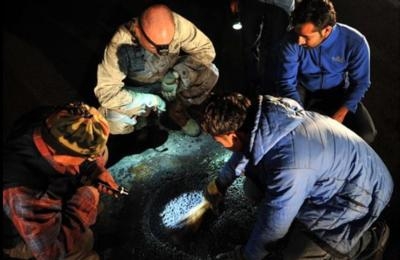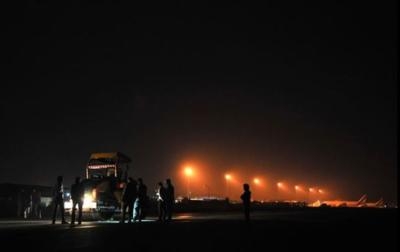Airfield Damaged By Magnitude 7.8 Earthquake April 25
Airmen and Nepalese officials worked together to repair the runway May 9-10, at the Tribhuvan International Airport in Kathmandu, Nepal.

Airmen with the 36th Contingency Response Group attached to Joint Task Force-505, along with members of the Civil Aviation Authority of Nepal teamed up to conduct necessary repairs to the airfield after it sustained damage following a magnitude 7.8 earthquake that struck the nation April 25. Subsequent heavy airlift with large amounts of relief supplies significantly increased aircraft traffic through the airfield, further straining the runway.
"The repairs will allow the continued throughput of humanitarian aid and relief supplies by ultimately preserving the life of the single international airport in Nepal," said Capt. Ryan White, assigned to the 36th CRG airfield operations. "This airfield is Nepal's lifeline for relief supplies and for international travel, so these repairs will help the airfield keep pace with the aid coming in so the Government of Nepal can keep getting assistance to the people who need it."
The two nations conducted joint assessments for three nights, prior to the repairs, by evaluating 20 critical areas along the entire 9,500-foot runway. They conducted visual assessments by evaluating for cracks, potholes or ruts, to ensure damage would not hinder operations or impact aircraft. They also accomplished a runway bearing capacity investigation to determine its strength by drilling in the pavement and testing the soil up to 4 feet below the surface.
The team's findings determined two critical areas in need of repairs that were located in the landing zones of the runway.
During the dark of the nights, after operations ceased at the airport, four Airmen joined a six-man Nepalese team to conduct the repairs.
With their combined efforts, they repaired 250 square feet of the runway the first night, and an area of eight square feet the following evening.
The Nepalese team and Airmen repaired the compromised locations by first removing the damaged surface, cleaning out debris, then filling the area with an asphalt mixture.
The repair efforts also proved to be an opportunity for the two nations to exchange and compare different repair techniques. For the first repair, the teams used the Nepalese technique for repair by using a cold mix asphalt and a sand seal, which is a sand and tar mixture.
The Airmen then worked with the Nepalese to accomplish the second repair by applying the method Airmen typically use, which is a prepared, harder cold mix asphalt able to withstand more impact weight without any additional repairs or applications.
"It was a great opportunity to share our runway repair operations with our partners and friends in this region," White said. "Together, we hope to come up with a viable option to repair the runway to sustain operations in Kathmandu."

Within one to three hours of completing the repairs, the runway was operational again -- just in time for the airport to open up and receive morning flights and thousands of pounds of relief supplies.
"These expedient repairs are critical at this point because it doesn't require a complete shutdown of the runway," said Capt. Clark Morgan, the 36th Mobility Readiness Squadron Contingency Engineer Flight commander. "If the runway closes, then aid stops. We want to help keep the missions moving to keep receiving humanitarian assistance relief supplies so the Government of Nepal can keep focusing on getting the aid to the people who need it while resting assured that the runway will stay open and operational."
The Nepalese officials and Airmen plan to continue doing daily visual assessments to ensure the integrity of the runway remains intact and to identify any additional repairs.
The 36th CRG Airmen arrived in Nepal from Andersen Air Force Base, Guam, May 5, to assist the Government of Nepal, Nepalese Army, and the U.S. Agency for International Development with airfield operations and processing relief supplies.
(USAF Images)
ANN Salutes Staff Sgt. Melissa White, Joint Task Force-505 Public Affairs
 ANN FAQ: Contributing To Aero-TV
ANN FAQ: Contributing To Aero-TV Classic Aero-TV: Bob Hoover At Airventure -- Flight Test and Military Service
Classic Aero-TV: Bob Hoover At Airventure -- Flight Test and Military Service Aero-News: Quote of the Day (11.12.25)
Aero-News: Quote of the Day (11.12.25) ANN's Daily Aero-Linx (11.12.25)
ANN's Daily Aero-Linx (11.12.25) ANN's Daily Aero-Term (11.12.25): Glideslope Intercept Altitude
ANN's Daily Aero-Term (11.12.25): Glideslope Intercept Altitude




